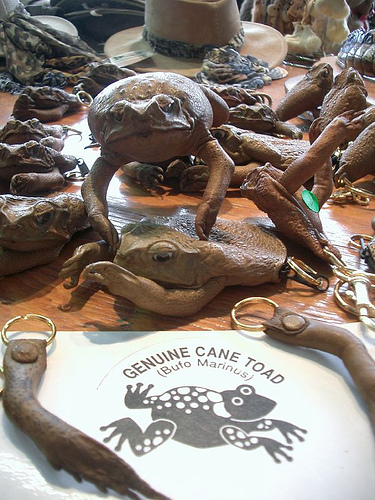Tyne McConnon, writing for ABC Australia (“Cow Pats Are Fast Food for Cane Toads”), notes that “researchers in the far north of Western Australia have found cane toads are following the cattle mustering lines in order to travel vast distances without water. It appears the wily pests have learned to use the manure (cow pats), left behind on the muster route as a reliable source of food and water. Kimberley Toad Busters chief, Ben Scott-Virtue, says the toads are able to absorb water from the manure into their stomachs. “They use those fresh cow patties a bit like McDonalds,” he said. “They sit up on top and they are rehydrating, and then with all the dung beetles and all the other beetles coming in to roll that cow pattie back into the soil, the cane toad is just pecking them off.”
Mr. Scott-Virtue says the adaptation could prove to be a problem in the future for pastoralists. “Pastures are going to get degraded because we have lots of cane toads out there eating lots and lots of dung beetles. “The largest number of dung beetles we have taken out of a single cane toads stomach is 53, and if you multiply that by the potential number of toads in the top end of Australia, some 200 million, you’re taking out a huge number of that invertebrate base.”
The cane toad (Bufo marinus) is native to South America but has been introduced to many countries in the vain attempt to control some insect pests. It was introduced to Australia in 1935 from Hawaii and released into canefields of far north Queensland to try to (unsuccessfully) control greyback cane beetles, a major pest of sugar cane. Soon after their introduction, cane toads spread rapidly and now occur through northern NSW and most of the eastern and northern parts of Queensland, including urban areas. Recently they have colonized the Northern Territory and they are predicted to move into the northern parts of Western Australia. Their rate of spread into the Northern Territory has been estimated to be approximately 30-50 kilometers per year. Where they occur, cane toads are very common, only localized high altitude and corresponding low temperatures seem to limit their distribution (Queensland Department of Natural Resources and Mines – Cane Toad fact Sheet).
Cane toads are relatively long-lived with specimens being recorded of 16 years. Females can weigh up to 2.5 kg (5.5 lb). They are active mostly at night and eat mostly ants, termites and beetles but have been known to take a wide variety of insects, frogs, small reptiles and even some small mammals. Under ideal conditions, they can reach adult size within 12 months. Cane toads can lay up to 35,000 small, black eggs at a time and form long, sticky strings attached to water plants or snags in slow moving water (Ibid.).
Cane toads are regarded as a major nuisance by the public and are believed to have a serious impact on native wildlife although there have been few studies aimed at quantifying the damage that they cause. In the wild, cane toads are believed to compete for food, shelter and breeding sites with native frogs. Also they are extremely toxic to many other animals such as native quolls and goannas. The parotoid glands of the cane toad release toxin when the animal is provoked or squeezed as happens in the mouth of a predator. They can cause extreme irritation to humans if incorrectly handled (Ibid.).
Currently there are no management strategies that are specific to cane toads. Actions have included detection and surveillance programs at the boundaries of their current distribution in an attempt to prevent their further spread. Agencies have investigated the potential for using parasites and diseases for their control but this work is in its infancy and would need extensive studies including an assessment of the potential impact of the control agent on native wildlife, particularly native frogs, before they could be used extensively (Ibid.).
Editor’s note: Alternative titles to this article are welcome. Your editor, being the politically correct and sensitive soul that he is, refrained from some more risque variations.



